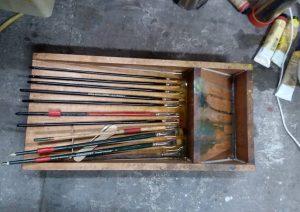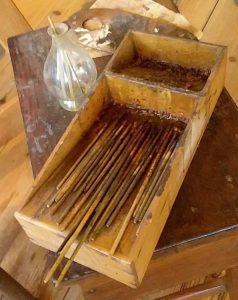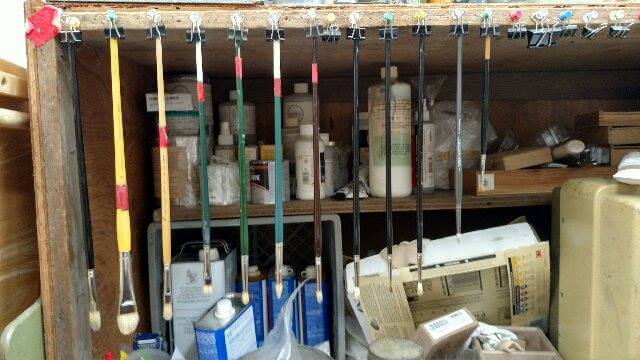Topic List
Tips for Choosing Brushes
Virgil’s Assessment:
Pages 144-145 of Virgil’s book include descriptions of brush types and their best applications.
Stiff bristle brushes were traditionally made from the backs of hogs while soft hair brushes came from animals such as sables. Tied bundles of hair were inserted and glued into ferrules, which were sections of goose quills.
On medium- to course-textured canvas, hog-bristle brushes work well in conjunction with oil paint straight from the tube or thinned with a bit of cold-pressed or alkali-refined linseed or walnut oil. They hold more paint than softer brushes and more readily accommodate a heavy application of paint. Impasto touches are best applied with them.
On smooth panels and with long paint, soft-hair brushes such as sable, ox hair, badger and mongoose work better than do hog -textured bristle brushes. Mediums with polymerized oils and perhaps balsams work well in conjunction with soft-hair brushes on smooth panels.
For something between hob bristle and sable, you might want to try badger or mongoose brushes, or synthetics that are made to replace them.
Tip: Before using new brushes, wash the stiffener out of them. If you don’t, the bristles will break off more easily. Washing them thoroughly with soap and lukewarm water will remove the stiffener. Hang them up to dry with the bristles pointing down, and after the water has left them, they’re ready to use for painting with oils.
Tips for Cleaning Brushes
It stands to reason that a brush will last longest and perform best when it is thoroughly clean.
Virgil has a section on caring for brushes on page 145 of his book. Some advice there on how to extend the life of a brush includes: avoid getting paint into the brush’s ferrule, where it is almost impossible to remove. Restrict the paint to the forward half of the exposed bristles.
Cleaning While Painting vs After Painting
While Painting:
Virgil has two containers of linseed or walnut oil on hand for brush cleaning. He wipes paint off with a rag or paper towel, then swishes the brush in the first container. He wipes the brush again, and then swishes it in the second container, wiping again. Once this is done, the brush is ready for a new color.
After Painting:
It’s very tempting to look for a way around cleaning brushes after the day’s painting session is over, and for a while, Virgil was suspending them in a can of linseed or walnut oil so that the bristles were submerged below the surface of the oil but the tips were not resting on the bottom of the can.
“However, I’m not an advocate of laziness, so I no longer do it that way, though it didn’t cause me any problems that I noticed. I’ve gone back to cleaning each brush with either oil or mineral spirits and then washing with soap (not detergent) and water, no matter how tired I am. After the soap-and-water wash, I hang them from push-pins stuck in the edge of my tabouret, with a binder clip holding the end of each brush handle so the bristles are pointing down. In a given session, I might use as many as 24 brushes, so it does take a lot of time to clean them after I’m done painting for the day.”
On Using Soap and Water to Clean Brushes
At end of the day, I wash the brushes with soap and water. No solvent used. Not hot water, though, but lukewarm to cold. Too hot and it could loosen the glue that holds the bristles in the ferrule, and possibly harm the bristles. Hang the brushes up to dry overnight with the bristle end pointing down. For this I use binder clips on the ends of the handles, and hang them from push pins stuck in the side of my tabouret.
Any kind of non-abrasive soap will work, as long as it’s rinsed out thoroughly at the end of the washing. I prefer white bar soap, simply because any color in the lather lets me know the brush isn’t clean yet.
Washing brushes in soap that has an abrasive in it will cause the bristles to wear down faster. Years ago I used Lava soap, which has pumice in it, to wash my hog bristle flats in order to wear down the edges and turn them into filberts. But if you don’t want to wear them down, don’t use Lava or any other soap that has an abrasive in it. (The Masters brush soap has an abrasive in it.)
Warning: some commercial brush soaps contain clove oil. I recommend avoiding anything with clove oil in it if there is a chance that any of it will get into the paint that goes on the painting. Clove oil in oil paint makes weaker, less durable paint films.
On Using Oils to Clean Brushes
ANY non-drying oil is a poor choice for brush cleaning: olive oil, corn oil, coconut oil, baby oil, Wesson oil, should not be used for anything in oil painting. The reason is that any of it that gets into the paint that goes on the painting will cause problems.
Safflower oil too, is questionable, because there are several varieties of it, some of which do not dry, and of those that do dry, some are now known to re-liquify years later. So my recommendation is to use linseed oil or walnut oil for rinsing brushes while you work, and in the brush tray in between sessions.
If you use a vegetable oil — such as walnut or safflower oil, or any oil commonly used as a binder in oil paints — wash out the brushes with soap and water afterward.
Safflower Oil
Some varieties of safflower oil would work [for cleaning brushes], but avoid any that have preservatives or vitamin E in them, because they won’t dry. Some safflower oils do not dry even without preservatives, so if you find some, test it to determine whether it will indeed dry in 7-10 days, and if it doesn’t, then only use it for cleaning brushes at the end of the painting day, followed by soap and water.
Linseed Oil
Linseed oil is usually available in large quantities at hardware stores and paint stores and it’s cheaper than what you find in art supply stores or health food stores.
In health food stores it’s called Flax Oil or Flaxseed Oil, for use as a nutritional supplement since it’s high in omega-3 fatty acids. But if it has vitamin E or other preservatives in it, it’s not suitable for art purposes because it won’t dry, so read the label before you buy.
Note that hardware store linseed oil is best used only for brush cleaning, as it’s less pure than artist-grade linseed oil, and therefore more likely to darken as it ages. So don’t use hardware store linseed oil for a painting medium or ingredient in a medium.
Food-grade flaxseed oil might or might not be suitable for art use, depending on whether it has an antioxidant added to it as a preservative. Vitamin E, aka alpha tocopherol acetate, is sometimes added to vegetable oils intended to be used in food.
In the US, labeling standards require that the ingredients be listed on the packaging.
Flax oil with preservatives in it would be all right for brush cleaning after the day’s session is over, provided it’s washed out thoroughly afterward with soap and water.
For brush cleaning during a painting session, it would be best not to use any non-drying oil. Preservatives would render flaxseed oil non-drying, or at least would interfere with the natural drying rate, thus making it less than ideal for that purpose.
Some people shape their brushes with lard oil: It might be important to note that fine art oil paintings are intended (or should be) to last a lot longer than lettering and striping on signs and vehicles. If any lard oil remains in an oil painting brush and thus gets into the paint going on the canvas, it would work to the detriment of the resulting paint film. So if you use this stuff, wash it out thoroughly afterward, so it doesn’t get into your paintings.
On Using Solvents to Clean Brushes
The problems with using mineral spirits or any solvent to clean brushes while painting are that:
- You are breathing its vapors and thus jeopardizing your health, and
- Some of the solvent remains in the brush and then gets into the paint that is being applied, potentially compromising the film strength and causing dull spots known as “sinking in.”
Thus it is better to use linseed or walnut oil for cleaning brushes while you paint, or, better still, to just use different brushes for different colors, so you need not clean brushes until after the session is over. At that time, mineral spirits can be used as the first stage of cleaning brushes, followed by soap and water, but there is still the exposure to the vapors. This can be minimized by doing the solvent rinse outdoors, of course.
Note that if I use solvent for brush cleaning, I do that part of the procedure outdoors, so my studio air is not contaminated with solvent vapors. Following the solvent wash with soap and water keeps the brushes from emitting vapors after they’re cleaned.
Which solvent is best? Virgil recommends Turpenoid Natural, a mixture of a citrus peel solvent and linseed oil. It has such powerful solvent action that it will eat through oil paint on paintings hundreds of years old, which makes it a good choice for cleaning brushes that have dried paint on them, but not a good choice for thinning oil paints or using as a painting medium or medium ingredient.
“Turpenoid Natural shouldn’t affect the glue holding the bristles in the ferrule. I’ve had no problems using it for cleaning brushes. I do always follow with soap and water.”
Avoid regular turpentine because it leaves a sticky residue or varnish in the brush.
Removing Dried Paint from Brushes
Paint that has dried on the brush can be removed with repeated washings with soap and water, with the lather left on the bristles each time, and then rinsed off later. Each time, more of the old dried paint will come off, and eventually, the brush will be restored to a useful condition if you do it enough times.
Dried oil paint will come out of brushes with soap and water if the lather is left on the brush for several hours, then rinsed off and re-lathered, as many times as it takes, sometimes over a period of days. The process can be accelerated by soaking them first in Turpenoid Natural for a while. Turpenoid Natural will eat dried oil paint no matter how old it is. Follow with soap and water, and hang the brush to dry, bristles pointing down.
Virgil: I doubt synthetic brushes can be restored once the bristles have curled. They’ll still be good for something; maybe painting moustaches, beards, grass, etc., so just give them a new assignment, and buy new brushes to do what the curled brushes used to do.
Brush Trays: An Alternative to Daily Cleaning
The brush tray shown below saves Virgil a lot of time after he’s done painting for the day. Philip Taylor made it, based on photos of two like it that he shot at the Rembrandthuis in Amsterdam in 2018. The bristle ends of the brushes sit submerged in linseed oil in between painting sessions, so the paint on them doesn’t dry, and they’re ready to use again the next day, after he wipes them off. (Virgil will leave the brushes in the tray overnight. Every few days they’ll get washed with soap and water, so this is not a long term alternative to brush cleaning.)


Drying Brushes
As noted above, Virgil hangs newly-washed brushes from push-pins stuck in the edge of his tabouret, using a binder clip to hold the end of each brush handle so that the bristles are pointing down.

Other Resources
- Cleaning recommendations from Rosemary Brushes.
- Advice from Winsor & Newton
